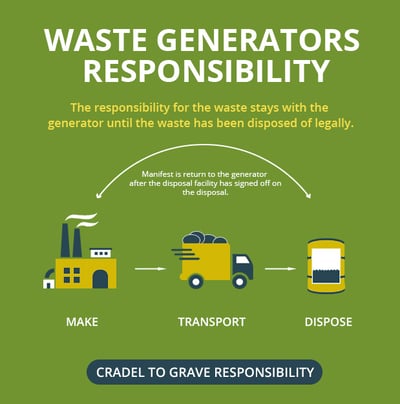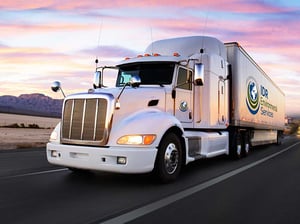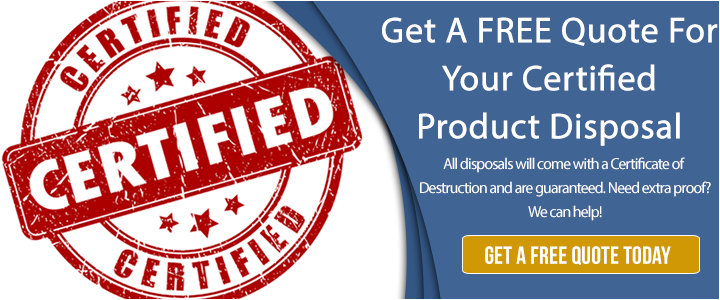“Cradle to grave” is a term used in industries that generate hazardous waste. It describes how a generator is responsible for its waste from initial generation through its ultimate disposal.
When a business generates hazardous waste, there is no expiration date or time limit that cradle to grave requirements are longer in effect. In other words, delaying the disposal of your hazardous waste or hiring someone else to transport it does not transfer responsibility.
If your company generates hazardous waste, you may believe that the processes you have in place ensure that the environment and community are safe. You may also have a false security that once hazardous waste leaves your property, it’s no longer a priority as part of your day-to-day operations, or that you are no longer legally responsible for the waste.
However, any disruption in your waste management practices - no matter how sound they are - can result in catastrophic consequences to human health, the environment, your community and the reputation of your business.
What could go wrong? A lot, and it’s these risks that highlight the importance of implementing a cradle to grave approach to managing hazardous waste effectively in your facility.
5 Ways To Break The Cradle To Grave Chain
Even when you believe you have a hazardous waste management approach, there can be openings for errors to occur.
Small oversights, such as improper labeling or incorrect storage containers, can lead to significant consequences that include environmental contamination or legal penalties.
Here are five examples of how one mistake can lead to a break in the cradle to grave chain:
- Improper labeling: Hazardous waste must be labeled properly to indicate the nature of the waste and its potential risks. Failing to use hazardous waste labels correctly can result in confusion among workers and lead to improper handling and disposal.
- Improper storage: Hazardous waste must be stored in containers that are appropriate for the type of waste your facility generates. Storage containers should also be resistant to chemical reactions and leaks. If the waste is stored improperly, a leak can contaminate the environment and pose health hazards.
- Illegal dumping: Illegally disposing of hazardous waste, such as dumping it in a landfill or pouring it down the drain, breaks the cradle to grave chain. This type of hazardous waste disposal poses a significant risk to public health and the environment and is a violation of environmental regulations.
- Failure to document: The term cradle to grave includes keeping proper documentation as an important part of the process. Failure to document the waste’s generation, storage, transportation and disposal can lead to noncompliance with regulatory requirements. Improperly documentation can also make it difficult to track the waste’s journey.
- Failure to transport waste properly: Transporting hazardous waste requires strict compliance with regulations and should include using licensed hazardous waste disposal companies. Failure to transport hazardous waste properly can lead to spills and leaks, posing a significant risk to public health and the environment.
A Successful Cradle To Grave Process
Now that you’ve read what can go wrong during the cradle to grave process, let’s take a look at a successful scenario that illustrates how a company should execute safe and legal hazardous waste disposal:
A pharmaceutical company produces a new drug for cancer treatment. During the manufacturing process, this company generates hazardous waste, including toxic chemicals, contaminated equipment, and expired or unused raw materials.
To ensure responsible medical waste disposal, the company implements a cradle to grave approach as part of its pharmaceutical waste disposal process.
First, the company identifies the waste generated in the manufacturing process and segregates it based on its characteristics. Employees then label the waste with any relevant information, including the name of the waste, its physical and chemical properties, and the generation date.
After the waste is collected, it is stored in appropriate vessels that are resistant to chemical reactions and leaks, ensuring that all hazardous waste container labeling requirements are met. These containers are stored in a secure and designated area that is monitored and equipped with safety features.
The company then contracts with a licensed hazardous waste management company to transport the waste to a treatment, storage and disposal facility (TSDF). The waste is treated or disposed of in accordance with regulatory requirements and permits, ensuring minimal impact on the environment and public health.
Throughout the entire process, the company maintains documentation that tracks the waste from its generation to its final disposal, providing a cradle to grave record. This record can be used to demonstrate compliance with regulations, facilitate audits, and identify opportunities for improvement in the waste generation and removal processes.
By implementing a comprehensive cradle to grave approach, the pharmaceutical company ensures it is responsibly managing its hazardous waste, from creation to the moment it is safely disposed of at the appropriate TSDF.

An After-thought? The Role Of Transportation
Transportation is at times viewed as an afterthought when a company is considering the cradle-to-grave process because it is seen as a relatively small component of the overall life cycle of a product.
The cradle-to-grave approach aims to consider the entire life cycle of a product, from the raw materials used in its production to its disposal or recycling. In fact, when companies think about the environmental impact of a product, they often focus on the production and disposal phases, since these are typically the most resource-intensive.
While transportation may seem like a relatively minor factor since it primarily involves moving products from one location to another, it still plays a significant role in maintaining a cradle to grave chain.
A properly licensed and experienced hazardous waste disposal company is worth its weight in gold and can help your company maintain federal and state standards. The right vendor will help you stay in compliance with these regulations, provide minimal disruption to your operations and perform these tasks in a cost-effective manner.
Let’s dive into how you can ensure your company chooses the right disposal company for the job.
How To Find A Hazardous Waste Disposal Company
You’ve done the work to ensure the hazardous waste your company has generated has been properly stored and maintained. Now you must turn it over to a disposal company that will transport it to the proper TSDF.
maintained. Now you must turn it over to a disposal company that will transport it to the proper TSDF.
It can be difficult to turn over control of your hazardous waste to another company, especially knowing that how that disposal company operates can impact your cradle to grave responsibilities. That’s why choosing the right local hazardous waste disposal is critically important and can provide you with the peace of mind you need.
Yet while many companies out there promise to dispose of your waste, not all may have the processes in place to fulfill that guarantee. Knowing which ones will do so will take more effort on your part than simply doing a quick Google search.
Check The California DTSC Database
The California Department of Toxic Substances Control (DTSC) maintains a registered hazardous waste transporter database. This database is a valuable tool that allows you to search by name, location or registration number. Within the location search tools, you can search by city, county or zip code if you’re looking for a disposal company within a certain region.
This database also provides information about when the transporter’s registration expires. Because a hazardous waste transporter registration is valid for only one year, conducting annual environmental audits of vendors handling your hazardous waste is a good idea.
Explore RCRAInfo
The Resource Conservation and Recovery Act Information (RCRAInfo) maintains hazardous waste information including an inventory system of hazardous waste handlers. This inventory includes all transporters, disposers, hazardous waste generators, treaters and storers.
When searching RCRAinfo Web, you can use a variety of criteria to get more specific results, including city, state, zip code and federal activities like if you’re looking for a transporter, recycler or a company that receives hazardous waste from off-site. Once you locate a disposal company, you can find additional information including permits, compliance with federal and state regulations, and cleanup activities.
Don’t Rely On A Broker
A hazardous waste broker is NOT the same as a hazardous waste transporter.
Brokers typically do not own a hazardous waste transportation business. They act as a middleman between the buyer (you) and the transportation company that takes your waste to a disposal site.
Brokers will take quoted prices they get from transporters and mark them up with whatever percentage the broker wants. It will then submit the quote to you for approval. In the end, you don’t even know who is handling your waste, and you’re paying more for that uncertainty.
To better understand if you are talking to a broker or a certified transporter, our article HAZARDOUS WASTE TRANSPORTERS VS BROKERS, shares some tips on how you can tell the difference and save your company from overspending and potential legal problems.
Look For These Additional Qualifications
Reputable hazardous waste services will:
- Identify uncertain waste streams through profiling and testing to ensure the right TSDFs receive the right waste
- Evaluate your waste streams to determine if the waste could be reclassified as non-hazardous waste and save you money on the disposal fees
- Develop site-specific plans that include training and emergency preparation so that the preparation that takes place before transport is safe and efficient
- Transport your waste to the proper recycling and disposal sites
- Prepare a manifest and other state and federal paperwork required for transport
- Offer evidence that your waste has been properly disposed of at the treatment and disposal facility
Take Advantage Of A Walk-Through
The best waste disposal companies will also offer a hazardous waste walk-through program. This service evaluates your hazardous waste management procedures, allowing for potential issues to be caught before they become costly mistakes.
A walk-through is also collaborative and ensures that your company and employees are protected and in legal compliance with transport areas like waste manifesting, proper labeling procedures and emergency readiness.
Do A Final Check
After you’ve narrowed down some options, here are a few tips to ensure your decision is sound.
- Double check a company’s background. This includes checking a list of state and federal licenses (Motor Carrier Permit, DOT Hazardous Material License, DTSC Transporter Registration, etc.).
- Dive into the company’s reputation. Ask for contact information of clients the disposal company has worked with so that you can hear about their experiences first-hand. If you’re looking for a local company, it’s likely that the small businesses the disposal company has served are in your community as well and can offer first-hand knowledge of their experiences working with the transporter you are considering.
- Ensure the disposal company has knowledge of your types of hazardous waste. Many types of hazardous waste require special disposal, from e-waste (electronic waste) to medical waste, pharmaceuticals, pesticides, chemicals, batteries and more. Each type has its own set of disposal regulations that must be followed, and many industries are seeing regulations quickly changing.
Know the importance of crossing state lines. If your waste is being transported across state lines, a disposal company should be aware of all laws pertaining to your type of hazardous waste in every state it travels.
Cradle To Grave And Your Business
Incorporating cradle-to-grave thinking into your waste management processes takes a lot of planning and careful consideration of the entire waste life cycle, including its final disposal. It requires a willingness to ensure your waste management solutions are sound and you are working with an experienced partner that can ensure your hazardous waste is properly disposed of at the appropriate facility.
The right hazardous waste disposal company will work with you to ensure you have the processes in place at your warehouse or industrial facility to store waste safely. The best disposal companies will also prioritize your company’s image as it takes over the transportation of your waste, ensuring people and the environment remain safe while your reputation remains intact.


Comment